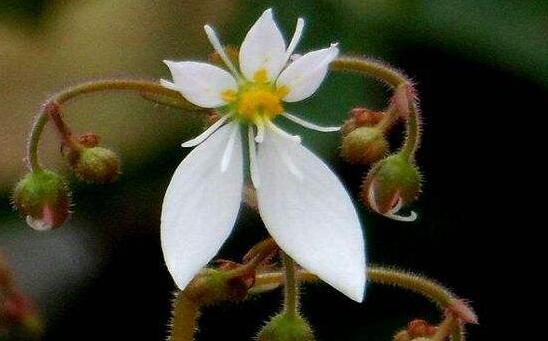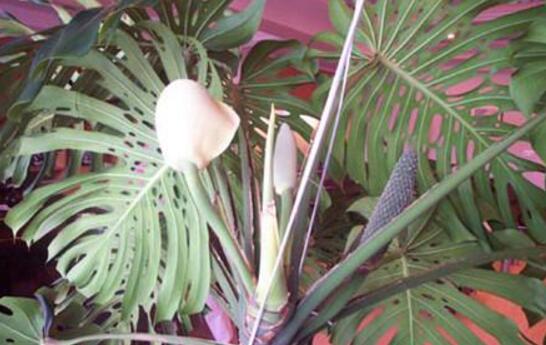Will Saxifraga die after flowering? how to manage / water less and stop fertilizing after flowering
Recently, many netizens have shared pictures of Saxifraga flowering with us. From these pictures, we can see that Saxifraga flowers are very beautiful in yellow and white, but many people are worried that Saxifraga will gradually die after flowering. Will Saxifraga die after flowering? How to manage Saxifraga after flowering? How does Saxifraga grow and blossom? The following editor will tell you the answer.
Will Saxifraga die after flowering?

Saxifraga does not die after flowering. It is a perennial plant with bilaterally symmetrical flowers. Sepals develop to reverse during the flowering period. There are usually 5 petals, 3 shorter and 2 longer. From the picture of Saxifraga, the flowers are as beautiful as birds with wings.
How to manage Saxifraga after flowering
1. Reduce the amount of water
In the two weeks after Saxifraga blossoms, the number and amount of watering should be reduced, so the plant will enter a dormant period, and the demand for water is low, so it is only necessary to ensure that the basin soil is not dry and transparent, and does not need to be watered too much. wait until spring comes and Saxifraga returns to normal watering.
2. Stop fertilization
Fertilization should also be stopped after flowering for the same reason as reducing watering, and after resuming growth, fertilizer can be applied every 20 days, mainly nitrogen fertilizer, if Saxifraga is cultivated properly, it can grow and reproduce for a long time.
How to raise Saxifraga to blossom
1. Choose the right soil
To let Saxifraga blossom, first of all to ensure that it can get enough nutrients in the growing period, and the choice of soil is very critical, into the choice of sandy soil, you can also use rotten leaf soil Gaza, before planting, we should pay attention to apply enough base fertilizer at the bottom of the basin.
2. the light should be moderate.
If the light is too strong, the leaves of Saxifraga will be scorched or yellowed; if it is too dark, it will make Arthur dim and affect its flowering, so the light must be moderate, not to let it be in dim light, and don't let it be exposed to the sun.
3. Watering is indispensable.
Some people raise Saxifraga can blossom year after year, while others do not see it blossom for several years. Careful comparison will find that many people seldom water Saxifraga, which is not conducive to its flowering, because Saxifraga prefers a humid environment.
4. Keep the environment ventilated
The ventilation of the environment is very helpful for Saxifraga flowering, the closed environment will hinder the air circulation, will lead to dry air, and even muggy conditions, and good ventilation can promote Saxifraga growth and flowering.
Conclusion: Saxifraga will not die after flowering, its flowers will wither, but the plant itself can grow perennially, if it is managed properly in the later stage, it will blossom again, and in order to make it blossom smoothly, light, soil and watering are the main factors. We should try our best to create an environment conducive to Saxifraga flowering in order to finally see beautiful Saxifraga flowers.
How to raise Saxifraga, the cultivation methods and matters needing attention / cool environment of potted Saxifraga
As Saxifraga has many effects and functions, more and more people plan to raise it, but some people do not know how to raise Saxifraga, but they do not know its living habits, and so on. Today, the editor introduces the breeding methods and matters needing attention of Saxifraga potted. After reading it, you will know that raising Saxifraga is not that difficult.
How to raise Saxifraga
Saxifraga is a very adaptable plant, which first appeared in the shady and wet rock crevices under the forest at an altitude of 400-4000 meters. It is relatively cool and humid and has high cold tolerance, which must be known before understanding how Saxifraga is raised.
Culture methods and matters needing attention of potted Saxifraga
Saxifraga was originally a wild plant, and later developed into an ornamental plant that can be potted. Below, we understand the breeding methods and matters needing attention of potted Saxifraga from the aspects of soil, light, temperature, watering, fertilization and so on.
1. Soil selection
Saxifraga has a general requirement for soil, but if it is a potted plant, we should try to choose the soil with good drainage and air permeability, such as the sandy soil with more organic matter, and the soil under the dense and wet forest and on the cool and moist canopy wall.
Note: pay attention to disinfect the soil before potting, you can put the soil in the sun to dry, so as to avoid the emergence of diseases and insect pests.
2. Requirements of lighting
Saxifraga requires that it cannot be directed, but it needs a certain amount of light. If the light is not enough, the leaves will be dim, but too much light may cause the leaves to turn yellow, so you need to pay special attention in summer and winter.
Note: Saxifraga should be moved to a cool place in summer, shaded if it cannot be moved, and sunny in winter.
3. Temperature control
The most suitable temperature for Saxifraga growth is 15-25 degrees, but its cold tolerance is relatively high, and it can survive in an environment of 5-10 degrees, but try not to let it be lower than the low temperature for a long time.
Note: there are some varieties of Saxifraga that are not cold-tolerant, such as Saxifraga tricolor, which may die when it is below 15 degrees, so pay attention to what varieties you raise.
4. Watering frequently
In the cultivation methods and matters needing attention of potted Saxifraga, watering is very exquisite. Water should be watered once a day during the growing period in order to keep the soil moist; watering should be reduced after flowering.
Note: Saxifraga likes wet environment, if the soil is too dry, it is easy to make the leaves yellow and fall off, so be sure to water frequently, but remember to water too much at one time, do not let the basin appear stagnant water.
5. Fertilization management
Saxifraga does not have a high demand for fertilizer, but it should be fertilized every 20 days during the growing season and before flowering, and can be stopped in winter.
Note: fertilizer should be applied from the root, do not let fertilizer contact with the leaf, this may affect the plant growth of Saxifraga.
Conclusion: the climate environment of each place is different, so when raising Saxifraga, the breeding methods and matters needing attention of potted Saxifraga is a very important reference. Only by protecting it attentively can we ensure the healthy growth of Saxifraga. And play the maximum ornamental value.
How to raise Saxifraga? is it easy to raise Saxifraga?
How to raise Saxifraga
The main results are as follows: 1. The reproduction method of Saxifraga is very simple, mainly using ramet propagation. When Saxifraga grows to a certain size, it will grow small plants at the end of the creeping branches. In spring, the small plants will be cut off, transplanted into a large flowerpot, and then covered with a thin plastic film. Pay attention to maintain a high temperature, wait for the root system to grow well, you can plant it in a small flowerpot and put it in a wet place for about two weeks to restore growth.
2. The best soil selected by potted Saxifraga is sandy soil rich in organic matter, and it also has good drainage, which can be made by mixing self-made culture soil with river sand. In addition to requiring a small amount of mature basal fertilizer when planting Saxifraga, fertilization during the growing season can apply dilute liquid fertilizer every two weeks, which will cause plant death if the concentration is too high.
3. Saxifraga likes a warm environment, and the most suitable growth temperature is between 15 and 25 degrees. Saxifraga is also hardy and can spend the winter at a low temperature of 5 degrees, but Saxifraga tricolor is not resistant to cold, and the overwintering temperature is 15 degrees. If it is lower than this temperature, it will die, so keeping warm in winter is also necessary.
4. Saxifraga likes a humid environment and needs high humidity in the growing season, so the basin soil should always be moist, but can not accumulate water. In summer, in addition to proper watering, it is also necessary to spray water to increase the humidity in the air and the humidity on the leaf surface. Saxifraga has a dormant period after flowering in spring and summer. At this time, you can water less, keep the pot dry, and change the pot or renew it after flowering every spring.
5. Saxifraga is to be raised in a semi-overcast environment, so it will be difficult to survive in a place where the sun shines all day. Because too strong light will lead to leaf burns, if the light is too weak, the leaves will not be bright enough, so shading treatment should be carried out in spring, summer and autumn, and brighter scattered light should be used for illumination treatment.
- Prev

Will the tortoise back bamboo blossom? the reason / environment and florescence of the tortoise back bamboo do not bloom have a great influence.
There is a saying in Chinese folk that the tortoise back bamboo blossoms, and it is difficult to see the set tree, meaning that it is as difficult to see the iron tree as it is to see the tortoise back bamboo bloom, so will the tortoise back bamboo bloom? The answer is yes. Does tortoise back bamboo blossom? tortoise back bamboo is found in tropical areas.
- Next

What if the triangular plum blossom falls? the reason for the triangular plum blossom is analyzed / man-made is the main cause
As a beautiful ornamental plant, many flower friends will plant triangular plum at home. It is said that when it blossoms, the scenery is very beautiful. However, some flower friends responded that the triangle plum blossom they raised had fallen off! What's going on? In fact, there are many reasons why triangular plum blossoms, among which man-made is a factor that can not be ignored.
Related
- Fuxing push coffee new agricultural production and marketing class: lack of small-scale processing plants
- Jujube rice field leisure farm deep ploughing Yilan for five years to create a space for organic food and play
- Nongyu Farm-A trial of organic papaya for brave women with advanced technology
- Four points for attention in the prevention and control of diseases and insect pests of edible fungi
- How to add nutrient solution to Edible Fungi
- Is there any good way to control edible fungus mites?
- Open Inoculation Technology of Edible Fungi
- Is there any clever way to use fertilizer for edible fungus in winter?
- What agents are used to kill the pathogens of edible fungi in the mushroom shed?
- Rapid drying of Edible Fungi

